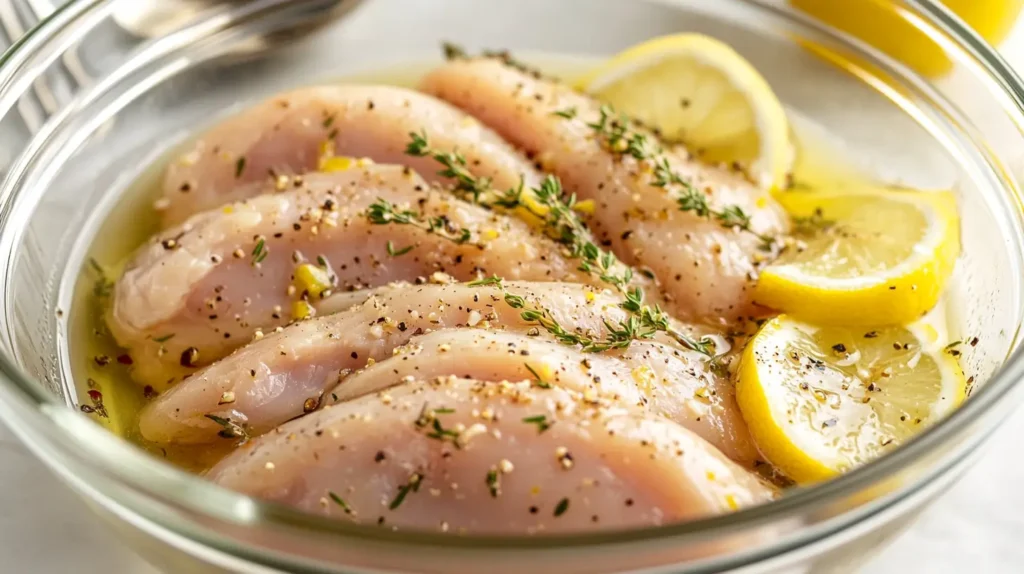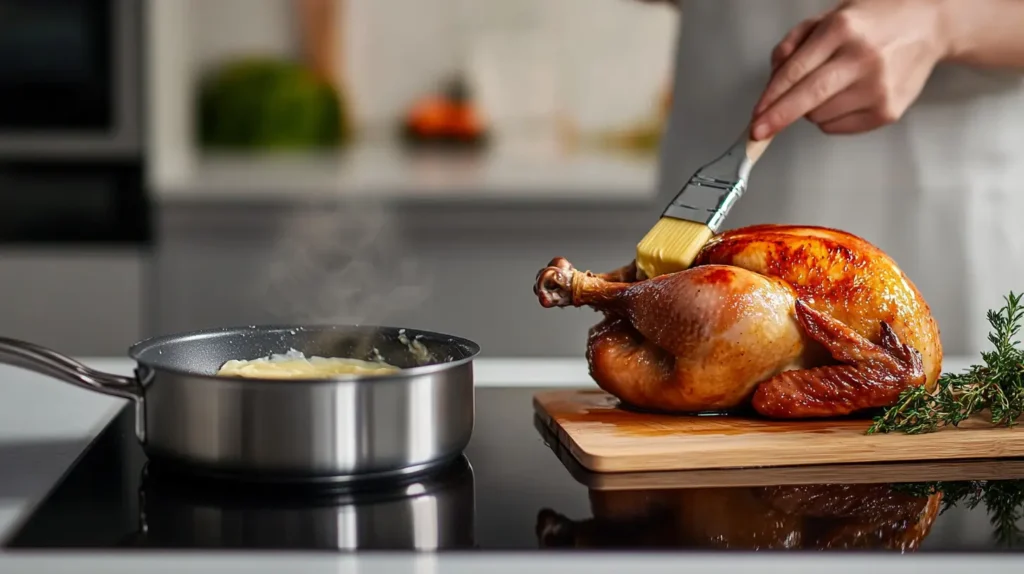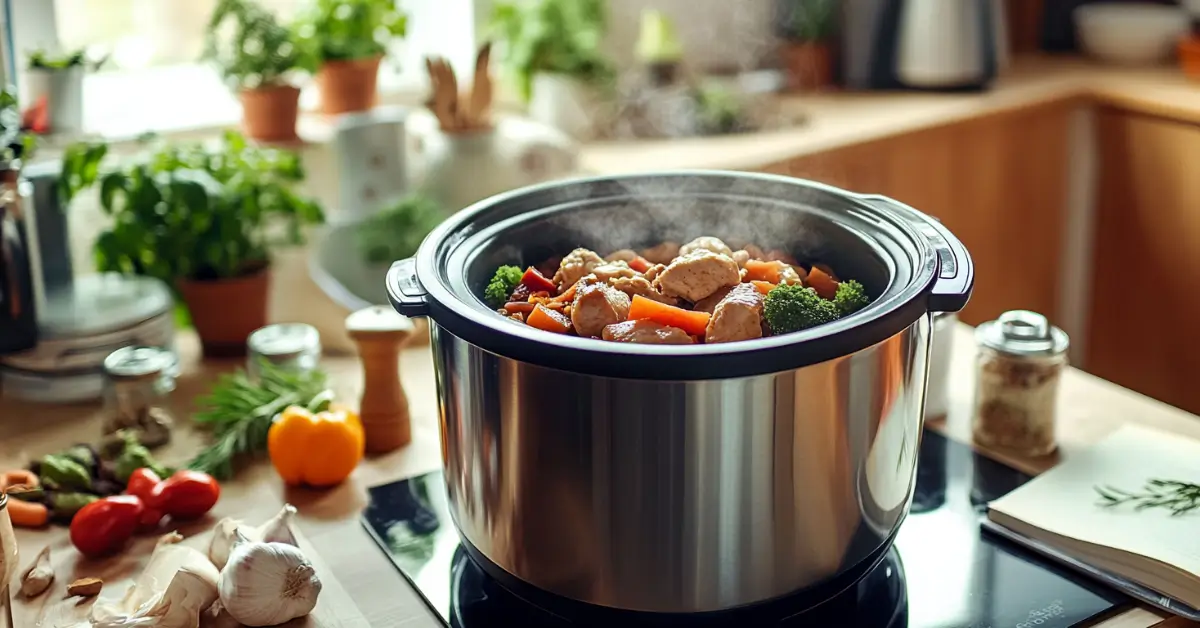When it comes to preparing chicken, achieving the perfect balance of flavor and juiciness can be elusive. What is the secret to moist chicken? This article uncovers the best practices and techniques to ensure your chicken stays tender and succulent, regardless of the cooking method.
Introduction
Importance of Cooking Moist Chicken
Perfectly cooked chicken is a cornerstone of countless cuisines worldwide. What is the secret to moist chicken? The answer lies in understanding how to lock in moisture while preserving the bird’s natural flavor. Dry chicken is not only unappetizing but also a wasted culinary opportunity.
Moist chicken elevates a dish, whether it’s grilled, roasted, or pan-fried. It retains its natural juices, delivering a more satisfying bite. Additionally, juicy chicken adapts well to various seasonings and recipes, making it a versatile choice for home cooks and professional chefs alike.
Common Mistakes Leading to Dry Chicken
Despite its simplicity, cooking chicken can go awry when basic principles are overlooked. Missteps that lead to dryness include:
- Overcooking the chicken due to high heat or extended cooking times.
- Failing to properly prepare the meat with brines or marinades.
- Using low-fat cuts like chicken breasts without accounting for moisture loss.
- Cooking at uneven temperatures, which compromises the texture.
Addressing these mistakes is integral to discovering what is the secret to moist chicken. By understanding common pitfalls, you’re already halfway to success.
Understanding Moisture
The Role of Protein and Fat
To understand what is the secret to moist chicken, one must first grasp the role of protein and fat. Chicken is composed of muscle fibers, which contain water and proteins that tighten when exposed to heat. Excessive tightening forces out the natural juices, leading to dryness.
Fat content also plays a role in retaining moisture. Dark meat, like thighs, contains more fat than breasts, making it inherently juicier. Knowing how to manipulate protein and fat levels allows cooks to achieve superior results with both light and dark meat.
How Moisture Retention Works
Moisture retention is influenced by several factors:
- Temperature control: Cooking chicken at the correct temperature ensures proteins coagulate without squeezing out moisture.
- Preparation methods: Brining and marinating enhance the meat’s ability to hold water.
- Cooking techniques: Methods like roasting and frying must balance heat distribution to prevent dehydration.
By mastering these elements, the answer to what is the secret to moist chicken becomes clearer. A combination of preparation and precise cooking ensures the chicken stays tender and juicy.
Preparation Techniques
Brining: Wet vs. Dry
Brining is a tried-and-true method for enhancing chicken’s moisture content. It’s often highlighted as a key to what is the secret to moist chicken. There are two main types:
- Wet Brine: Submerging chicken in a water-salt solution adds moisture and infuses flavor. Additional spices and herbs can be added for depth.
- Dry Brine: Coating the chicken with salt and letting it rest draws out juices, which are reabsorbed, creating a concentrated flavor.
Wet brining works well for lean cuts like breasts, while dry brining is ideal for roasting whole chickens. Both methods prepare the meat to retain moisture during cooking.
Marination Secrets
Marination combines acids, oils, and seasonings to enhance flavor and moisture. But what is the secret to moist chicken when it comes to marination? The balance of ingredients matters:
- Acids (like lemon juice or vinegar) tenderize but should be used sparingly to avoid breaking down proteins excessively.
- Oils coat the chicken, helping it retain moisture during cooking.
- Aromatics such as garlic, herbs, and spices add complexity to the dish.
A well-executed marinade not only boosts flavor but also safeguards the chicken from drying out.

Cooking Methods
Roasting Chicken Right: Temperature and Timing for Moist Results
Roasting chicken to perfection requires attention to temperature and timing—two crucial factors when asking, what is the secret to moist chicken?
- Temperature: Roast at a steady 375–400°F for even cooking. Use a meat thermometer to ensure the internal temperature reaches 165°F.
- Timing: Avoid overcooking by pulling the chicken from the oven as soon as it reaches the desired internal temperature.
To maintain moisture, baste the chicken with its juices or a butter-based sauce during cooking. This creates a flavorful crust without compromising the juiciness inside.
Pan-Frying Tips for Juicy Chicken Every Time
Pan-frying is ideal for achieving a crisp exterior while keeping the inside tender. So, what is the secret to moist chicken when frying?
- Use a combination of butter and oil to prevent sticking and enhance flavor.
- Sear chicken over medium-high heat, then reduce to medium to cook through without burning.
- Avoid overcrowding the pan to ensure even heat distribution.
Rest the chicken for a few minutes after frying to allow the juices to redistribute, ensuring every bite is flavorful.
Grilling Without Drying Out
Grilling is another popular method, but it can quickly dry out chicken if done improperly. The secret lies in the following steps:
- Preheat the grill: A hot grill sears the chicken, locking in its juices.
- Indirect heat: Cook thicker cuts like thighs over indirect heat to prevent drying out.
- Frequent basting: Apply marinade or butter throughout the grilling process.
Master these techniques, and the answer to what is the secret to moist chicken will be evident in your results.
Special Techniques
Sous Vide: Foolproof Moisture
Sous vide cooking is one of the most reliable methods for ensuring chicken stays moist and tender. This technique involves vacuum-sealing chicken and cooking it in a temperature-controlled water bath. By maintaining a precise and low cooking temperature, the chicken retains all its natural juices without the risk of overcooking.
To achieve what is the secret to moist chicken with sous vide, you can finish the chicken with a quick sear in a hot pan to add a caramelized exterior. This method guarantees consistently juicy and flavorful chicken, perfect for everything from simple meals to gourmet dishes.
Slow Cooking for Tender, Moist Chicken
Slow cooking is an excellent option for tender, fall-apart chicken that remains moist. By cooking at low temperatures for extended periods, the meat becomes tender while soaking in its own juices or added liquids like broth. This method is ideal for stews, shredded chicken, or one-pot meals.
When learning what is the secret to moist chicken, slow cooking offers a hands-off approach that ensures flavorful results. Use aromatic vegetables, herbs, and spices to enhance the taste while preserving the meat’s natural succulence.
Using a Meat Thermometer
A meat thermometer is essential for perfecting what is the secret to moist chicken. It ensures the chicken is cooked to an internal temperature of 165°F (74°C)—the point at which it’s safe to eat but still juicy. Insert the thermometer into the thickest part of the meat without touching the bone for the most accurate reading.
Using a thermometer prevents the guesswork and helps avoid overcooking, which is the primary culprit behind dry chicken. This simple tool is invaluable for achieving perfect results every time.
Enhancing Flavors
Adding Fat for Juiciness
Fat is a key player in maintaining the juiciness of chicken. Adding butter, oils, or even a creamy sauce enhances the meat’s moisture and flavor. Fat acts as a barrier, locking in the juices during cooking and delivering a rich, satisfying texture.
Understanding what is the secret to moist chicken means incorporating fats into your preparation. Whether it’s a butter-based marinade or finishing the chicken with a drizzle of olive oil, fat elevates both the texture and taste of your dish.
Broth and Butter Basting for Moist and Flavorful Chicken
Basting chicken with broth or melted butter during cooking keeps it moist and flavorful. This technique creates a protective coating that prevents water loss while infusing the chicken with savory flavors.
For those exploring what is the secret to moist chicken, frequent basting during roasting or grilling ensures even moisture distribution. Adding herbs or garlic to the basting liquid can further enhance the dish’s aroma and taste.

Post-Cooking Tips
Resting Time: Why It Matters
Resting chicken after cooking is a crucial step in achieving juicy results. When chicken cooks, its juices are driven toward the center. Allowing it to rest for 5–10 minutes before slicing enables the juices to redistribute evenly, ensuring every bite is succulent.
Understanding what is the secret to moist chicken involves patience. Resting also helps the meat retain its structure, making it easier to cut and serve without losing its moisture.
Slicing Against the Grain to Preserve Moist Chicken
The way you slice chicken can make a significant difference in its texture. Cutting against the grain shortens the muscle fibers, making the meat easier to chew and preserving its juiciness.
To truly master what is the secret to moist chicken, pay attention to how the chicken is carved. Proper slicing not only enhances the dining experience but also ensures that the chicken remains tender and flavorful.
FAQs on What is the Secret to Moist Chicken
What is the secret to the juiciest chicken?
The secret to the juiciest chicken lies in three key factors: preparation, cooking, and post-cooking techniques. Start by brining or marinating the chicken, which infuses moisture and flavor. During cooking, use moderate heat and a meat thermometer to avoid overcooking—chicken is perfectly cooked when its internal temperature reaches 165°F (74°C). Opt for moisture-retaining methods like sous vide, slow cooking, or frequent basting with butter or broth. Finally, let the chicken rest for 5–10 minutes before slicing to allow the juices to redistribute evenly.
How do you make chicken soft and tender?
Making chicken soft and tender requires tenderizing techniques and controlled cooking methods. Marinating the chicken with acidic ingredients like yogurt, buttermilk, or lemon juice helps break down muscle fibers, softening the meat. Alternatively, brining with a salt solution enhances tenderness by altering protein structure. Cook at lower temperatures for longer durations, such as in slow cooking or sous vide. Avoid high heat that can toughen the meat and always slice the chicken against the grain for the best texture.
How long to marinate chicken?
The ideal marinating time depends on the cut and size of the chicken:
- Chicken breasts or thighs: 1–4 hours.
- Whole chicken: 4–12 hours.
- Delicate marinades (acid-heavy): No longer than 2 hours to avoid mushy textures.
For the best results, keep the chicken refrigerated during marination and use a well-balanced marinade with both acidic and fatty components to maintain flavor and moisture.
Is it better to bake chicken at 350 or 400?
The choice between 350°F and 400°F depends on the desired result:
- 350°F: Suitable for slower, even cooking, ideal for whole chickens or bone-in cuts. This temperature helps retain moisture and prevents overcooking.
- 400°F: Best for faster cooking, yielding a crispier exterior. It’s great for smaller cuts like boneless chicken breasts or thighs.
Regardless of temperature, ensure the internal temperature of the chicken reaches 165°F (74°C) for safe consumption while keeping it juicy.
Conclusion
Summarizing Key Takeaways
So, what is the secret to moist chicken? It lies in a combination of preparation, precise cooking methods, and careful post-cooking handling. Techniques like sous vide, slow cooking, and using a meat thermometer provide consistent results, while brining and marinating enhance moisture and flavor.
Adding fat, basting, and resting are essential steps to retain juiciness, while slicing against the grain ensures tender pieces. By implementing these strategies, you’ll consistently serve chicken that is juicy, tender, and packed with flavor. Follow these principles, and every chicken dish you prepare will be a culinary success.





